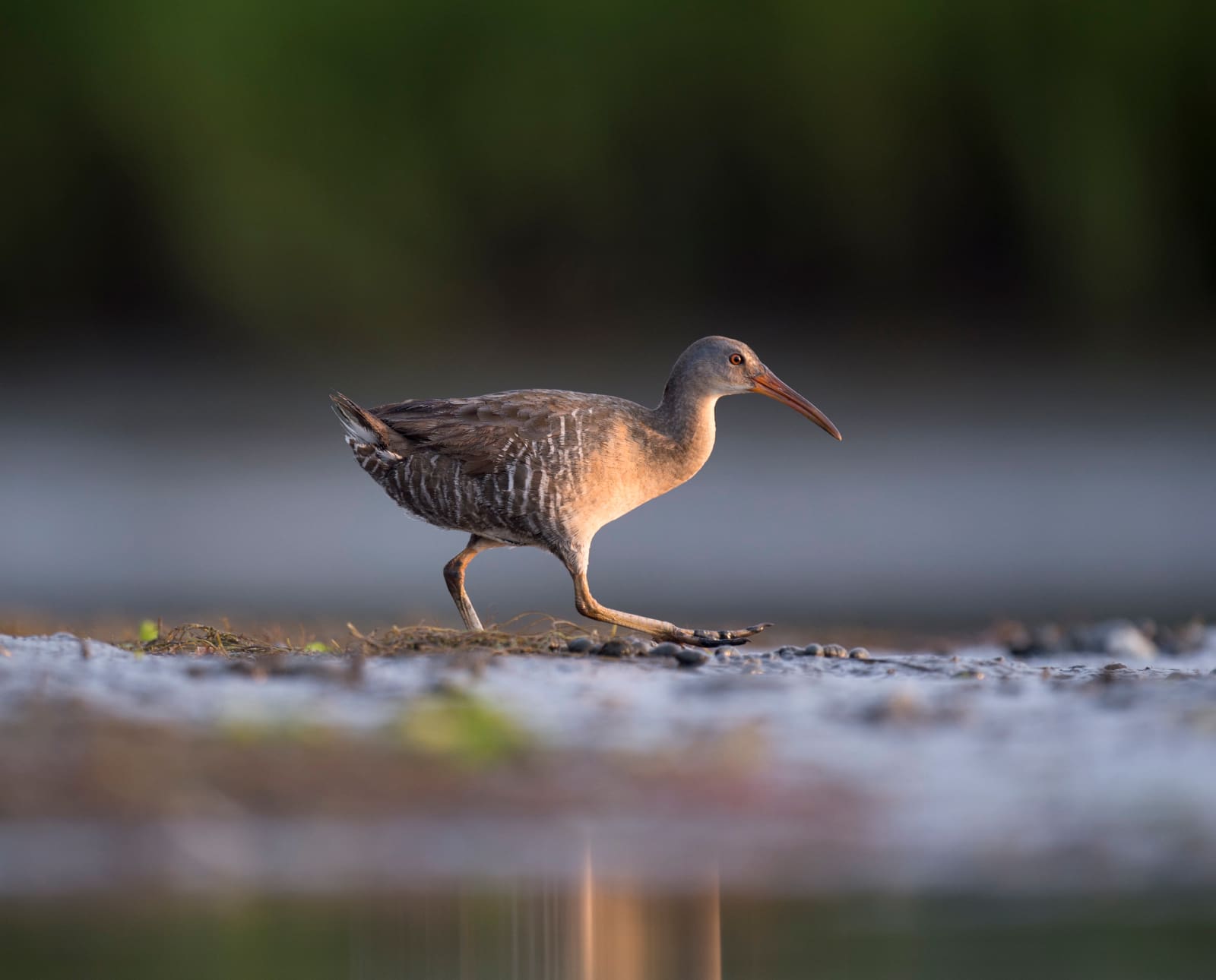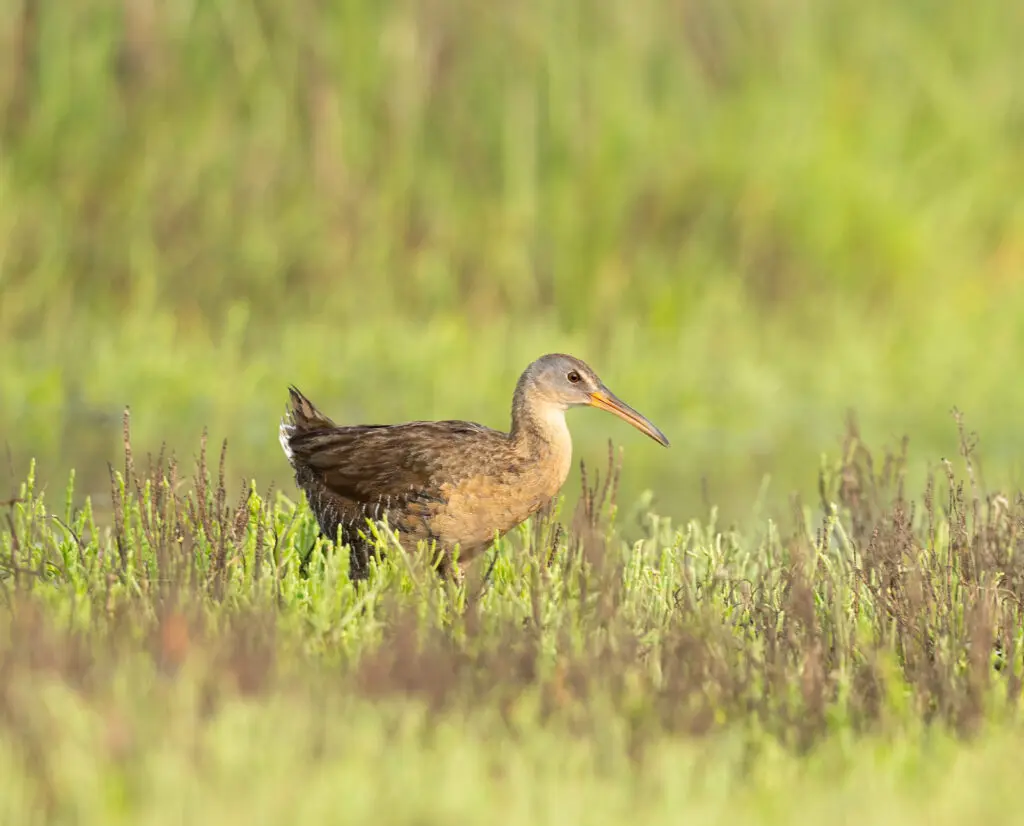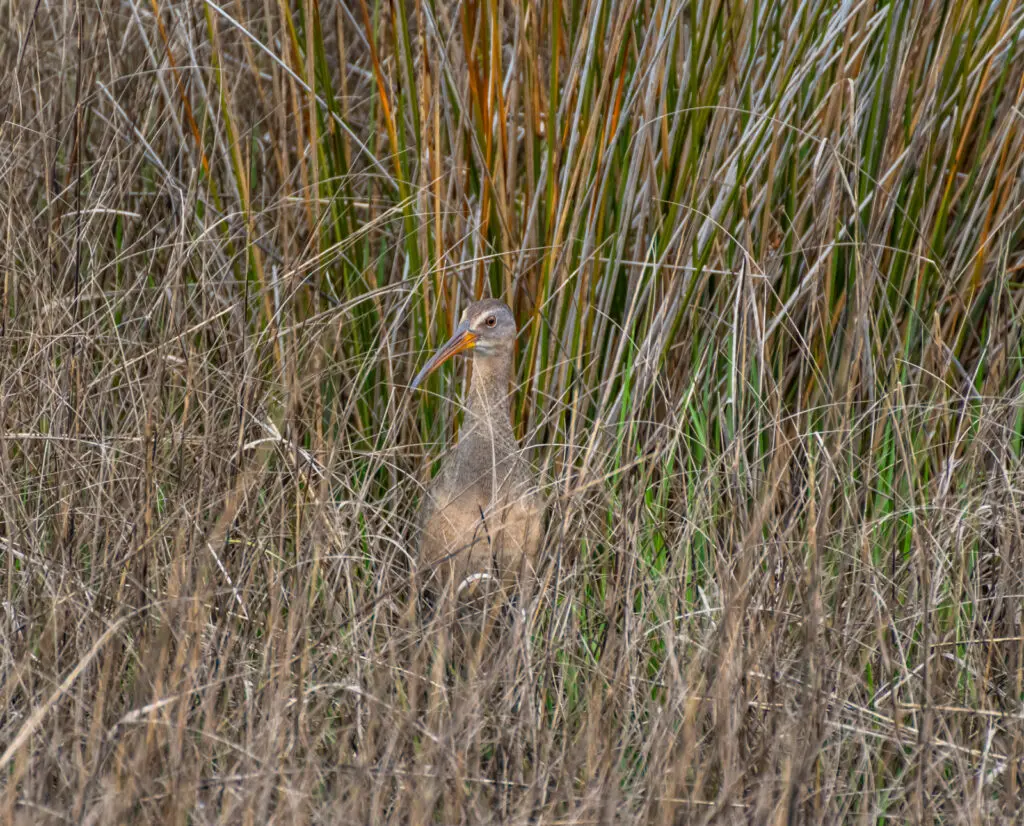Home » Migratory Bird Species » Guide to Hunting Clapper Rails
Guide to Hunting Clapper Rails

Mike Adams is an outdoor writer, wildlife biologist, and educator…
Learn to hunt this misfit waterbird, from drives to push poling; the clapper rail offers an exciting wingshooting opportunity and wonderful table fare.
Clapper rails don’t sing. They cackle. It’s a guttural call emanating from somewhere deep within each tiny bird that reverberates with enough force to trigger a cascade. Once one rail calls, every rail within earshot erupts into its own chorus. The cacophony sends a ripple through the salt marsh and shatters its peaceful silence like glass.
Listen to more articles on Apple | Google | Spotify | Audible
Today, however, there is no peace, and there is no silence. It’s already been shattered. A violent collision of arctic air and Gulf Stream winds just smacked the mid-Atlantic shore. Now, the rails and I are caught knee-deep in the chaos.
Not Quite Waterfowl, Not Quite An Upland Bird
Clapper rails have drab plumage the color of wet clay. They have spindly legs, matchstick toes, and a bill like a crescent moon. Clapper rails exist largely unnoticed in the marsh grasses they call home, except when hunting fiddler crabs at low tide. The crabs don’t make it easy. They dart in and out of their muddy burrows all day long, and for a hungry rail, the hunt becomes a high-stakes game of Whac-A-Mole. If it’s not fiddler crabs, it’s periwinkle snails, penny-sized Baltic clams, or, occasionally, live mice.
The few people who can stand to appreciate this rail’s enigmatic and grotesque life are the niche crew of hunters who have grown to love them. Or, more accurately, their meat. Pan-seared in foaming butter, clapper rail meat encounters few culinary rivals. And the hunting adds zest. On the front end of a riling storm, a clapper rail hunt can be bountiful and downright outrageous. More often than not, it’s story-worthy.
“You see that forecast?” Jeremy asked me over the phone the night before the hunt. It’s going to be a blowout! Meet me at the tracks at 6 a.m. Don’t forget the dog.”
Nor’easters arrive in the mid-Atlantic every fall with the same fidelity as winter chills or summer sweats, so I expect Jeremy’s call once the September weather radar becomes bloodied with red. The railroad tracks he wants to hunt were abandoned in the 80s. Now, they extend three-quarters of a mile through public land salt marsh, bulging from the flat land like a varicose vein. During a cataclysmic flood, the marsh turns into a bay, and the tracks provide the only high ground for rails to refuge.
The morning of the hunt, Jeremy spills out of his truck with his oversized waders bulging in folds around his midsection, shotshells loose in his kangaroo pocket. Kai, a three-year-old Boykin Spaniel trained on black ducks, gracefully follows behind. He trots over to sniff Boone. Boone’s stout body and silky red coat, typical of most field goldens, stands in stark contrast to the dark and compact build of a Boykin. But Jeremy and I figure they’ll make a good pair of clapper rail retrievers. If nothing less, it’ll be a good warm-up for duck season.

How to Hunt Clapper Rails
Clapper rails are the most heavily hunted rail species on the Atlantic Flyway, but that isn’t saying much. A 2022 US Fish and Wildlife Service report estimated clapper rail hunters on the East Coast at a measly 2,900 individuals. That same year, in contrast, engaged 175,500 waterfowl hunters. The typical rail hunter spent just 1.8 days in the field, but they averaged a harvest of eight birds in that short time.
The high success rate has much to do with the clapper rail’s behavior. They can be brutally predictable. On a regular tide cycle, clapper rails linger along the banks where most of their forage resides. In a single parcel of marsh, that accounts for habit on the scale of hundreds if not thousands of linear miles. These conditions require rail drives.
Clapper Rail Drives
Rail drives can be done alone, with a buddy, or with a dog. Walk the edge of a river bank and force a rail’s options. A pushed rail will scurry in front of you, swim the river, sneak behind you, or take flight. Of those options, it will favor two: sneak behind you or scurry in front. This is where a partner comes in handy. Cut off the double-back route and drive the marsh to some terminal point like the confluence of two streams. Once a rail loses runway, it will resort to flight, an awkward task for the rail, and offer a relatively easy shot to a hunter.
Hunting A Flood Tide
The better option is to wait for a flood tide. September storms provide ideal conditions. As waters swell, clapper rails cling to whatever cover they can find. The higher the water, the less cover available. Walk an abandoned railroad on a biblical flood, and clapper rails emerge at your feet.
“Out to the left!” Jeremy’s voice strains against the wind.
Gaunt legs dangle beneath the rail as it rockets from a grove of low-lying cedars. By the time I see it, the bird catches a tailwind paralleling the tracks. I shoulder my gun but can’t find the bird behind the bead. Then, it’s gone. I look up from the barrel and see the bird gliding back onto the tracks about fifty yards away. It flees into an orchard of bayberries.
“It can happen quick!” Jeremy yells from my side.
You would think that hunting clapper rails on a flood tide would be as easy as foraging mushrooms on an inoculated log. Clapper rails, however, are survival experts.
They don’t just run; they zip and disappear. When you see a rail dart between cover, it’s like glimpsing a shooting star. You know what you saw, but by the time you realize it, it’s gone. And when you try to steal another peek, nothing’s there. It leaves you wondering if you saw anything in the first place.
Boone and Kai work the bayberries as Jeremy and I follow behind like a pair of grouse hunters tailing English Setters. Clapper rails bounce between their snouts. Boone flushes one rail from a bayberry bush that scampers across the track ballasts and runs into Kai. That bird busts while Kai flushes another rail that skitters behind him and hangs up underneath a cedar. It turns invisible. The rails dance in and out of sight like ghosts, glued to the ground until one succumbs to the pressure.
The rail bursts from behind Jeremy’s right boot, finding the tailwind before we knew it was off the ground. Jeremy, a self-proclaimed teal shooting expert, is habituated to quick, jerky, and accurate shots, and drops the rail in a clump. The wind is so loud, I barely hear the blast. Kai’s bob for a tail cuts squiggles in the Nor’easter wind as he retrieves the bird. The rail rests in his jaws like a water-saturated robin.
How to Wingshoot Clapper Rails
It takes no more than a few shots at clapper rail to realize the commodity of time. Jeremy makes quick shots look easy, but hunters like myself benefit from taking a moment to aim.
Clapper rails almost always leverage a tailwind; when they do, they rocket. Without a tailwind, however, clapper rails either hover or cover distance as clumsily as a plastic bag in the wind. That leaves shooters plenty of opportunity to place their beads. Patience also builds up shot distance. Clapper rails live in fragile bodies, and even with size 8 pellets, a close-range shot risks peppering the bird to the point of inedibility.
Prepare for multiple flushes. When cover becomes sparse, rails pool up in pockets. Several years ago, Jeremy and I hunted the tracks and ended up driving a hoard of rails down to where they end–a tangle of twisted metal at the edge of a riverbank. Mayhem was unleashed as three-quarters of a mile’s worth of birds flushed at once. The excitement skewed our shots, and of the two we actually did drop, one landed across the creek. Jeremy had to birddog that one.
As Kai brings the rail to Jeremy’s hand, Boone flushes another bird, and it’s barreling for me. It buzzes past my head so close that I feel the thumps of its wings in my eardrums. I pivot. My finger slips the safety and finds the rain-soaked trigger. It’s cold to the touch. I draw on it, and a shot rings out, muffled by the wind—a miss. I re-find my bead. The bird teeters on the edge of shotgun range. I drag the trigger again, and the rail folds.
Its featherweight corpse catches a gale that sails it like a kite out into the roiling abyss. At that same time, Boone launches into the water with the same confidence he has diving into a swimming pool on a bluebird day.
Rain pelts my cheeks like liquid shrapnel. The wind howls. I shout commands, but Boone can’t hear me. Jeremy retrieves his bird from Kai while looking down the ballasts and yelling something, but I can’t hear him, either. I slide down into the bay and feel the force of the tide against my knees.
Between Jeremy and I lay a landfill of carnage. Dead reeds and seagull carcasses pile on the rocks while an empty Gatorade bottle and a cordless buoy ride a northeastern gale to the same destination. The swollen tides want to whisk me there, too; their threats tug on my waders.
I turn back and squint my eyes against the wind to find Boone. He’s twenty yards out, head bobbing in the whitewater like a seal. Beyond him, a tuft of cordgrass pokes out from the flood, and a clapper rail floats at its base.

The Art of Push Poling
Today, the art of push poling belongs to the redfish guides of the Carolinas, but its history holds roots in clapper rail hunting.
The operation usually occurs on a flat-hulled boat, something like a Barnegat Bay sneakbox, although hunters traditionally used a rail skiff. A rail skiff resembles an unusually long and slender dugout canoe with a tapered bow that pushes high into the air when the poler stands at the stern.
The pole, upwards of fifteen feet long and terminating in a pronged head, is designed to catch creek bottoms. The low profile of a rail skiff, along with the flat hull and slender build, affords hunters a ticket to deluged clapper rail sanctuaries. As the boat noses up to a hideout, rails are forced to flush, and with a shooter positioned at the bow, the method can be extremely effective.
Boone sucks in a mouthful of bay water while latching onto the floating clapper rail. He takes a serpentine turn back for shore as I egg him on, slapping the water in front of me. Whitewater breaks over Boone’s snout as he slithers towards the bank, but he snags on a mat of floating reeds before he gets there. When he tries to swim over it, the reeds sink, then float back up in front of him. He’s chipping away at the mat but mostly swimming in place.
Boone flashes a look of panic. I shuffle through the reeds, and I reach for his hunting vest. When I find my grip, I hoist him out of the water and onto land. With his paws secure on wet rock, Boone releases the rail. I pick it up and hold it with an upward palm. It’s barely bigger than my hand. I rub my thumb over its scythe-like bill, feeling every dimple and crest. Then, I rub the ridge of its breastbone and feel its plumpness. I tuck the rail in my wader pocket and climb back to the tracks with Boone.
When we get there, I ask Jeremy what he had shouted.
“I said,” Jeremy’s voice fighting the wind, eyes squinting against the rain, “I bet Boone wishes we brought the skiff today!”
Mike Adams is an outdoor writer, wildlife biologist, and educator hailing from salt marshes of the mid-Atlantic. His work has appeared in numerous outdoor publications, where he uses hunting and fishing narratives to explore deeper issues in conservation or ecology. In the fall, you'll find him on his Barnegat Bay Sneakbox hunting ducks with his dog, Boone. Any other time of year, he's usually out on the salt marsh, catching crabs or fishing for striper.





